
 |
Tea Clipper |
 |
| from TeaAntiques.com | ||
| Edition One Hundred and Sixteen |
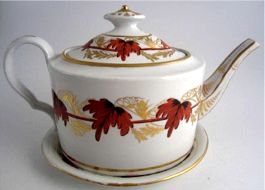
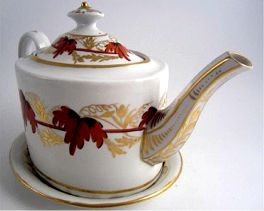
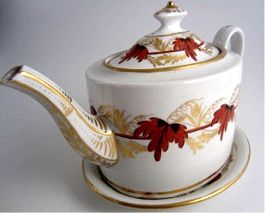
An attractive Coalport teapot and stand of oval straight sided shape, beautifully decorated with a red and gilt vine leaf design, c 1800-1805. The teapot has its original oval stand, which is lovely to have with it. The teapot is of a pleasing straight sided oval shape and fits comfortably on its stand. The decoration is of a bold centrally placed band around the teapot's body, comprising large red stylised vine leafs linked by a red line, about which are finely gilded leaves and vine tendrils.
More details of this item and other tea related antiques can be found by visiting my web site at www.TeaAntiques.com.
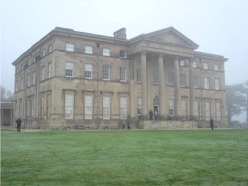
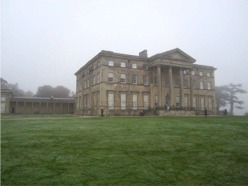 Near
to the Shropshire village of Atcham, stands a most handsome classical country
house - Attingham Park. This magnificent mansion was built for Noel Hill, 1st
Baron Berwick to the design of George Steuart (sic) in 1785. It stands on the site of
an earlier house known then as Tern Hall.
Near
to the Shropshire village of Atcham, stands a most handsome classical country
house - Attingham Park. This magnificent mansion was built for Noel Hill, 1st
Baron Berwick to the design of George Steuart (sic) in 1785. It stands on the site of
an earlier house known then as Tern Hall.
The house is within a large country estate, all now run by the National Trust. Having had a most enjoyable visit to this house, it can be said to be one where the National Trust have injected some thought about the way in which the house and estate are presented to make it exciting to all age ranges.
The park was laid out to the design of the famous landscape designer Humphry Repton and includes woodlands and deer park. Within the park is a walled garden which, in the time of the house, would have provided it with all its vegetable and fruit needs. Today this is being restored and a large portion of it is now being tended, the produce of which goes to be used in their restaurant; and also is for sale in a shop.
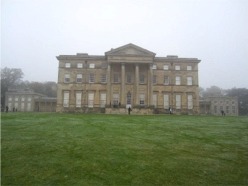
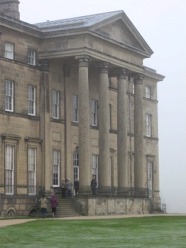
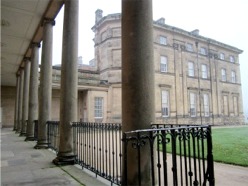
The house itself is a Palladian style stone mansion comprising the main central block which has a central pediment raised high above a set of four Ionic giant order columns with two pavilion wings set towards the back linked with a colonnade. Handsome elegant stone steps curve up on each side of the front entrance to the piano nobile on which the principle rooms are situated. The steps and front of the entrance terrace are edged with a fine set of iron railings.
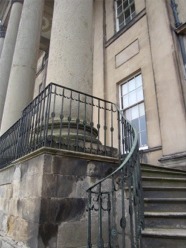
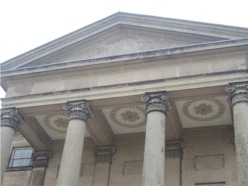
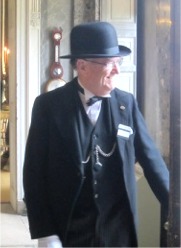
On arrival at the front door of the house, the door is opened by a National Trust staff member dress as a formal Butler, in black tailed coat and bowler hat; there to greet you into this amazing house with a wide smile.
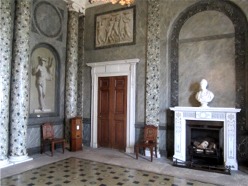 Although
the Entrance Hall appears a good size and imposing, originally it would have
felt a lot larger and even more imposing, as it was originally open through to
the sweeping staircase. But in the early Nineteenth century architect John Nash
added a wall across the Hall and created behind it a Picture Gallery.
Although
the Entrance Hall appears a good size and imposing, originally it would have
felt a lot larger and even more imposing, as it was originally open through to
the sweeping staircase. But in the early Nineteenth century architect John Nash
added a wall across the Hall and created behind it a Picture Gallery.
The house is arranged in what was known as the 'Regency fashion', where rooms were furnished and decorated in a rich and opulent fashion. As you walk from room to room, they progressively seem to get more and more richly decorated. The house was essentially set out so that one side of the house was predominantly the domain of the ladies of the house, the other to the gentleman.
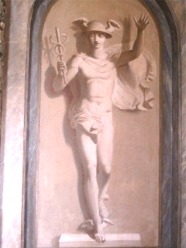
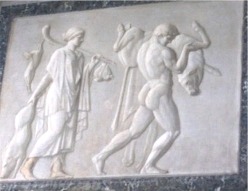
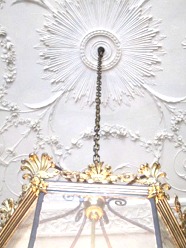
Leaving the Entrance Hall to the right, one progresses through a series of rooms designed for the entertainment of the Ladies of the house. The first of these rooms is the Main Drawing Room, which is absolutely delightful. Decorated in a pale blue with pink and gold trimmings, the room abounds elegance. Lit by a beautiful crystal glass chandelier, its light reflected at the ends of the room by massive gilt framed mirrors making the chandelier reflection appear to go on to infinity.
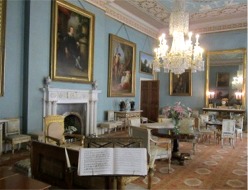
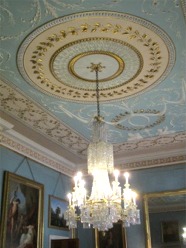
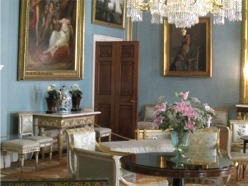
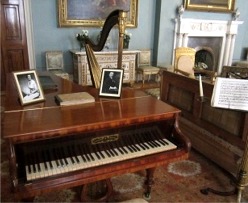
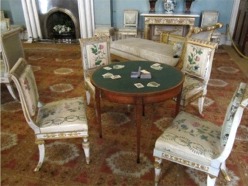 The
furnishings of the room are typical for a Ladies Drawing Room, silk covered gilt
framed chairs, plush and gilded furniture, etc. To one end of the room is a
grand piano and golden Harp, instruments for their entertainment and pleasure.
To the other end of the room a base inset card table for an evening game of
cards. The lovely panelled carpet design reflects the similar border frieze
around the ceiling.
The
furnishings of the room are typical for a Ladies Drawing Room, silk covered gilt
framed chairs, plush and gilded furniture, etc. To one end of the room is a
grand piano and golden Harp, instruments for their entertainment and pleasure.
To the other end of the room a base inset card table for an evening game of
cards. The lovely panelled carpet design reflects the similar border frieze
around the ceiling.
The next room is no less imposing, this time furnished with a rich red and gold theme. In the centre of the room is a circular table laid for afternoon tea. On the table is a silver tray on which stands a Victorian silver teaset of teapot, milk jug, hot water jug and some elegant cups and saucers. There are four gilt framed French styled arm chairs around the table. It is not difficult to imagine ladies sat round sipping tea and having a little chat or gossip. Set within a recess a a comfortable settee in red silk, backed by a gilt framed mirror, the perfect place to relax after tea.
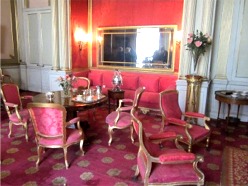
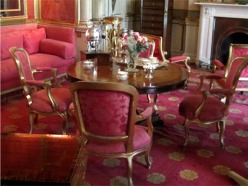
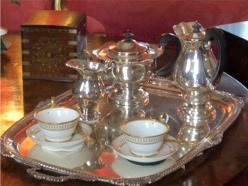
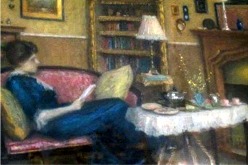 In
a passage way beyond this room I spied a painting in 'impressionist' style
showing an Edwardian Lady relaxing with her own afternoon tea perched upon her
comfortable settee and reading her letters. Her afternoon tea beautifully set
upon a small low table, covered in a starched white linen table cloth edged in
lace. A silver teapot and milk jug and vase of flowers are amongst the items
that grace her table.
In
a passage way beyond this room I spied a painting in 'impressionist' style
showing an Edwardian Lady relaxing with her own afternoon tea perched upon her
comfortable settee and reading her letters. Her afternoon tea beautifully set
upon a small low table, covered in a starched white linen table cloth edged in
lace. A silver teapot and milk jug and vase of flowers are amongst the items
that grace her table.
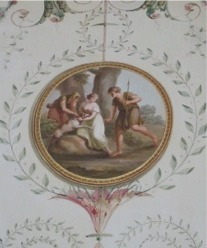 The
next room comes as quite an unexpected surprise! A completely circular Boudoir
with five doors and two fireplaces, an intimate room for the Ladies. The
classical decoration is both light and elaborate. The panels in the wall and
ceiling have finely painted roundels. The decoration is abundant with the theme
of love, with cupids, arrows and ribbons. Angels are depicted in the ceiling
roundels. There are eight fine columns around the room and a window and mirror
that reflects the parkland and provides the deception of the room being bigger
than it is.
The
next room comes as quite an unexpected surprise! A completely circular Boudoir
with five doors and two fireplaces, an intimate room for the Ladies. The
classical decoration is both light and elaborate. The panels in the wall and
ceiling have finely painted roundels. The decoration is abundant with the theme
of love, with cupids, arrows and ribbons. Angels are depicted in the ceiling
roundels. There are eight fine columns around the room and a window and mirror
that reflects the parkland and provides the deception of the room being bigger
than it is.
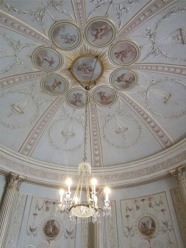
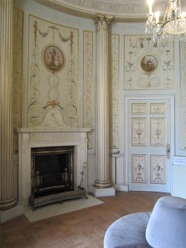
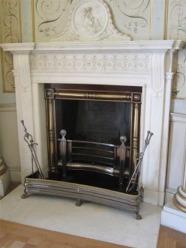
On the other side of the house in the domain of the Gentlemen things are much plainer and more austere. The Library is lined with book cases with gilt meshed doors. Above the bookcases the walls are of a rich red and hung with paintings. In the centre of the room a circular double sided desk Each side of the desk are a curved double door cupboard with drawers. The sides of the cupboard is formed with gilt headed caryatids in Regency taste.
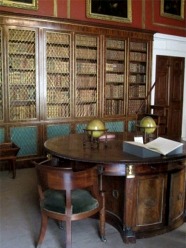
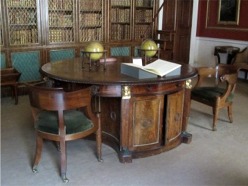
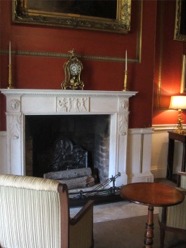
The Dinning Room, again comes as rather unexpected, it is so opulent and richly decorated, certainly a very fine room for lavish dinners or banquets. The room is decorated in a Cranberry Red, perfect colour for evening candle lit dinners. The National Trust have gone to great effort to try to create such fine and opulent dining by the way in which is presents the table. It is exquisitely laid up with a large white table cloth and table linen.
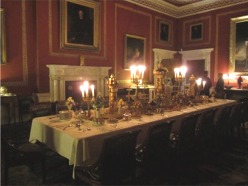
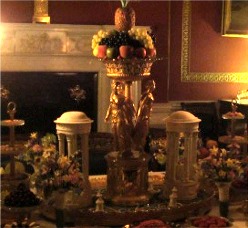
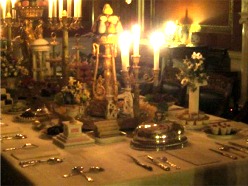
The candles that light the room may not be actual candles with real flames, but the effect they give is wonderful, as is the the effect of the use of artificial fruit, flowers, meats, etc. Many of the family's silver and silver gilt items are used to adorn the table together with family porcelain. It is worth a trip to this beautiful house to see the spectacle of this dining room setting alone. It is a room in which to pause and to take it all in in slow time, appreciating it in all its very fine detail.
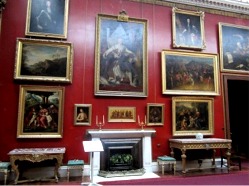
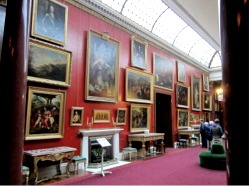
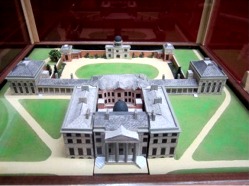
The Picture Gallery, added by John Nash, is also no less impressive. This immense gallery, the walls painted a rich claret give the perfect foil to the many paintings hanging round the double height walls. The Gallery is cleverly designed with a curved glass frieze to allow natural light down into the Gallery. An accurately detailed model of the house allows the visitor to appreciate the layout of the house, but also the changes that were made by the addition of the Picture Gallery.
Below stairs we see the domain of the servants who ran the house. This again is very cleverly depicted with lots of snippets of interesting information for the visitor for them to conger up what the life of a servant was like.
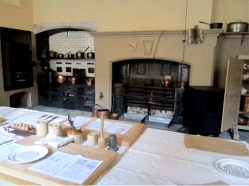
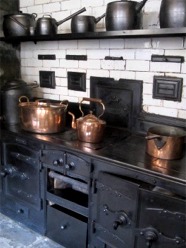
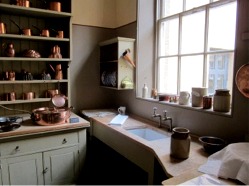
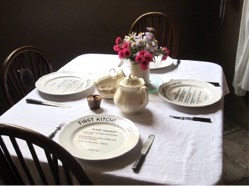
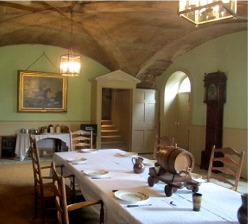 The
large kitchen was the engine room of the house, the throbbing heart keeping the
house running smoothly. A large cooking range, older spit roasting fire, dresser
with shining brass pots and moulds were some of the elements of the kitchen. In
the centre of the kitchen floor a massive refectory table used for the cooks to
prepare the foods. Tools for the cooks work were laid out with regimented
precision. Each member of below stairs staff had their own title and knew
exactly where their place was in the pecking order of servants, from the cook
down to the lowly scullery maid. To help us understand the hierarchy, tables
have been set in various rooms, such as the kitchen, house keeper's room
servants' hall, etc., with plates where the various member of staff might have
eaten on which is written their tile, the work they performed and their
salaries.
The
large kitchen was the engine room of the house, the throbbing heart keeping the
house running smoothly. A large cooking range, older spit roasting fire, dresser
with shining brass pots and moulds were some of the elements of the kitchen. In
the centre of the kitchen floor a massive refectory table used for the cooks to
prepare the foods. Tools for the cooks work were laid out with regimented
precision. Each member of below stairs staff had their own title and knew
exactly where their place was in the pecking order of servants, from the cook
down to the lowly scullery maid. To help us understand the hierarchy, tables
have been set in various rooms, such as the kitchen, house keeper's room
servants' hall, etc., with plates where the various member of staff might have
eaten on which is written their tile, the work they performed and their
salaries.
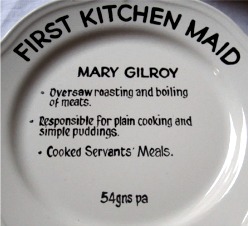
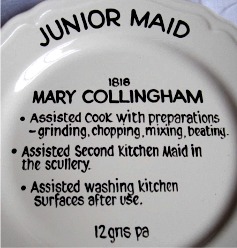

It was lovely to see some things that would have been ready for an afternoon tea for upstairs or downstairs - maybe for the house keeper? This shows how important taking tea was at this period, whether using fine bone china, silver or silver plate. Dainty sandwiches and cakes were all the vogue.
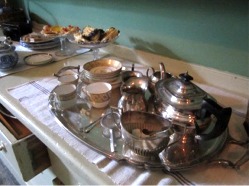
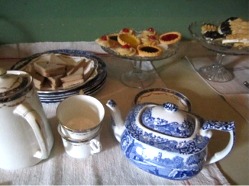
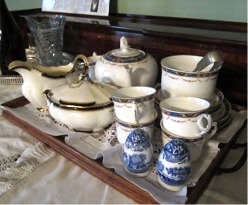
Much of the family's valuable silver wares would have been kept downstairs with in a strong room. Items from this fine collection are on view within display cabinets. Amongst the fine silver, a beautiful early silver pear shaped teapot with fruit wood handle; silver gilt candelabra; silver crested wine cooler, cruet frames, etc.
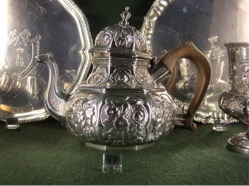
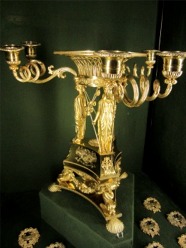
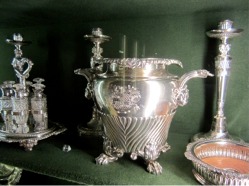
Walking into a final room, I was unaware for a moment that I had indeed entered the National Trusts shop! It has been cleverly laid out to look like a room with some antiques and artefacts providing the perfect setting to display the gifts that were on offer for sale - this I felt was very clever.
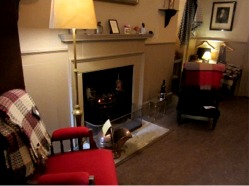
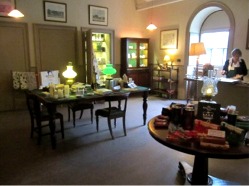
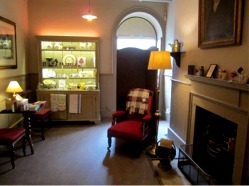
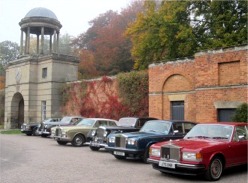
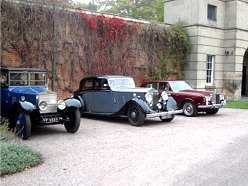 Outside
of the house, the National Trust are making the most of the gardens and parkland
with a wealth of events through out the season. These can be guided themed
walks, things aimed at the children such as Easter egg trails, nature trails,
mushroom foraging, etc. The day I was at Attingham, there was one of the local
regions Rolls-Royce motor car rally. Parked in the back courtyard of the house a
collection of beautiful and stylish Rolls-Royce cars of all ages and style. This
was an interesting spectacle to behold and enjoy.
Outside
of the house, the National Trust are making the most of the gardens and parkland
with a wealth of events through out the season. These can be guided themed
walks, things aimed at the children such as Easter egg trails, nature trails,
mushroom foraging, etc. The day I was at Attingham, there was one of the local
regions Rolls-Royce motor car rally. Parked in the back courtyard of the house a
collection of beautiful and stylish Rolls-Royce cars of all ages and style. This
was an interesting spectacle to behold and enjoy.
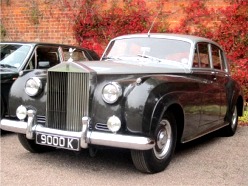
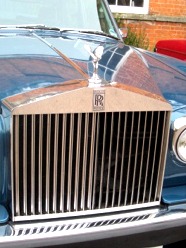
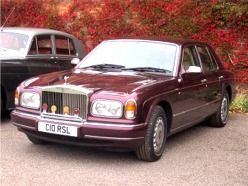
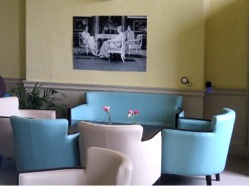
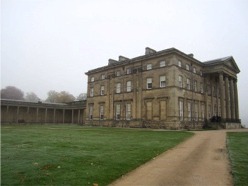 Attingham
Park also boasts a number of places in which to take some refreshment or tea. I
took an enjoyable cream tea in one of the Pavilion Wings to the house. However,
on the top floor of the house you can enjoy a more refined formal afternoon tea
served by waitresses in black dresses with starched white pinafores. Whichever
you choose, I am sure it will be enjoyable.
Attingham
Park also boasts a number of places in which to take some refreshment or tea. I
took an enjoyable cream tea in one of the Pavilion Wings to the house. However,
on the top floor of the house you can enjoy a more refined formal afternoon tea
served by waitresses in black dresses with starched white pinafores. Whichever
you choose, I am sure it will be enjoyable.
A day spent at Attingham Park, can be a day very well spent with lots to see and do.
Attingham Park
Near Atcham
Shropshire
Map:
Click
here
Website:
Click here
To review past newsletters, just follow this link:
Past newsletters.
To subscribe to this free newsletter -
Click here